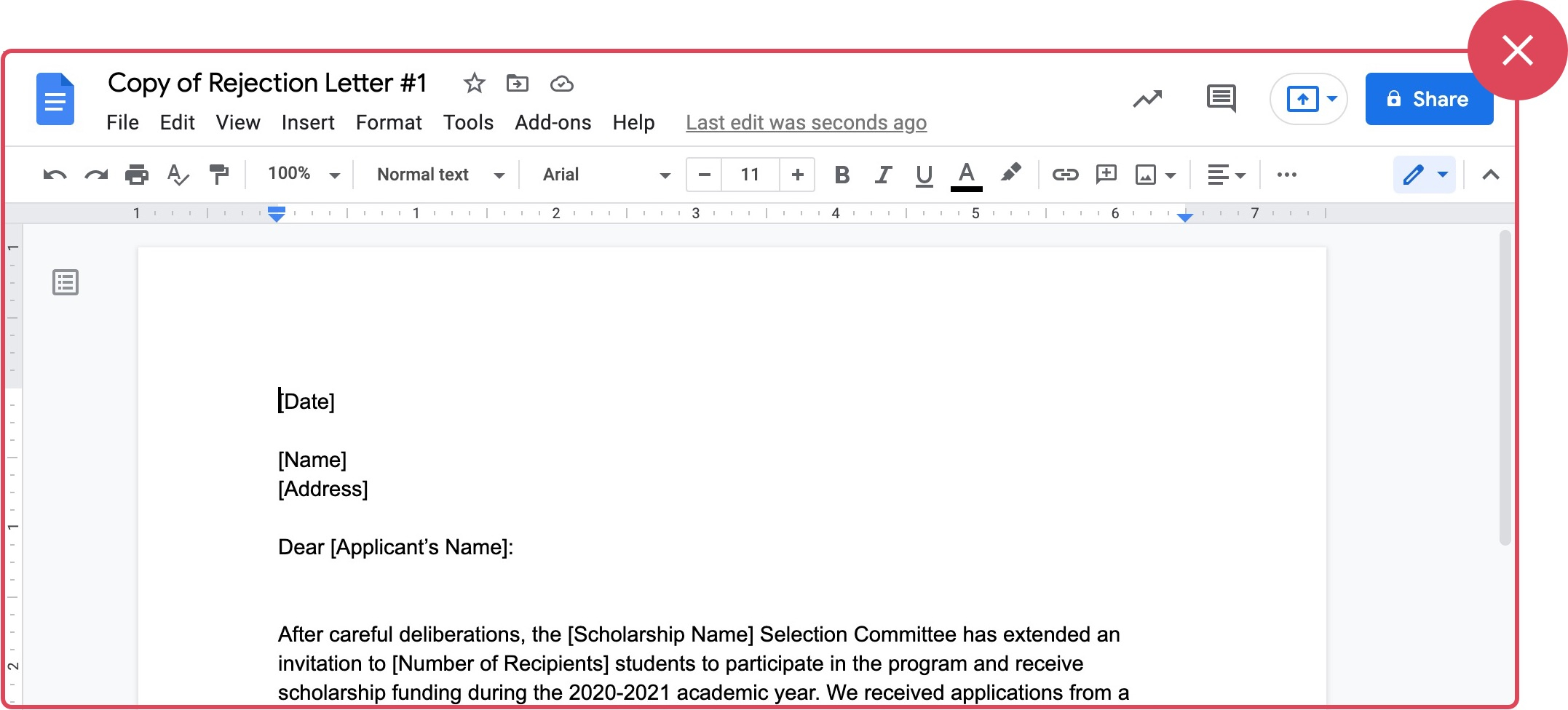Scholarship Rejection Letter Template: Nobody likes Being Rejected
This is the part of the job no program manager or evaluation team enjoys. Sending out a scholarship rejection letter to each candidate that was not selected as an award recipient. Though no one likes to be rejected, it is better to know that you are not going to receive a scholarship, than to be left wondering about the outcome. Even if you have already announced who the recipients are publicly, the professional and courteous thing to do is send a rejection letter to candidates that weren’t selected.
If your scholarship program is doing interviews of candidates to continue filtering your selection pool, you may choose to send each ineligible person an applicant rejection letter after interviews have been completed. However, some program managers may opt to send rejection letters to ineligible candidates that have been eliminated prior to these interviews.
Scholarship rejection letters tend to be short and to the point, but you may be wondering what to include in yours? Below, we’ll explore what should be in your program’s applicant rejection letter, and we’ll give you a template you can use to help make the task of writing and sending them a little easier.
How to Write a Scholarship Rejection Letter
Scholarship applications are rejected for a wide variety of reasons. Sometimes it is because the essays submitted weren’t as high in quality as those submitted by other candidates. It can also be related to poor GPA, low amounts of extracurricular activities, neglecting to submit all required materials, etc..
The simple fact is many scholarship organizations receive thousands of applications with every round of their program, and not everyone who applies can be an award recipient. Here's a scholarship rejection letter template for your reference. Whatever the reason prompting a rejection letter to an applicant, these are the components you should include in yours:
- Header with the date, your organization’s name, and address
- Optional: add your website and/or phone number
- A greeting such as “Dear [Applicant’s Full Name],”
- Body of the scholarship rejection letter
- The scholarship name should be mentioned in the first sentence
- You may want to mention how many applications were received
- You could also include some of the criteria that was used to choose the recipients
- The body might also include a sentence like “Your application materials will be kept on file for additional consideration should any of the finalists decline to participate in the program this year.”
- Optional: If feasible, you could include why the candidate you are sending a letter to was eliminated from the pool of applicants
- A closing or conclusion - If they are still eligible to apply for future scholarships, include when the next round of the program will be as well as where they can find information
- Ending salutation such as “Sincerely, [Name, Title]”
- Optional: Include contact information
Make the Task of Sending Scholarship Rejection Letters Easier
To ease the stress of sending rejections, we have created a free scholarship rejection letter template. Get yours for free here. SmarterSelect can also help you automate many of the elements of your scholarship program. From messaging candidates to creating your scholarship applications, and even sending award letters, our application management software streamlines the entire process of running a scholarship program.
See what we can do for your program by signing up for a free trial today!
FAQ's
1. Why do scholarship applications get rejected?
Scholarship applications are rejected for several reasons. It could be that the essays submitted weren’t as high in quality as those submitted by other candidates, poor GPA, low amounts of extracurricular activities, neglecting to submit all required materials, etc.
2. What components should be included in a scholarship rejection letter?
Here are the main components that should be included in a scholarship rejection letter, in addition to basic salutations:
- Header with the date, your organization’s name, and address. A greeting such as “Dear [Applicant’s Full Name],”
- Body of the scholarship rejection letter with the criteria that was used to choose the recipients, and conveying professionally the reason for rejection.
- Closing note - If they are still eligible to apply for future scholarships, include when the next round of the program will be as well as where they can find information.



